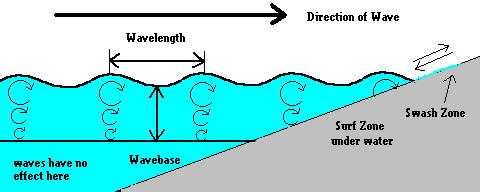
Waves are driven by the wind. It makes the water at or near
the surface move in a circular motion. That is, if you watch a floating
object move as waves pass ... it would move in tiny circles over and over
again. This "circular motion" extends below the surface to a level
known as the wavebase. The wavebase is about half the wavelength
of the surface waves (distance between wave crests). Click
here
to see an animation.

This wave action only becomes interesting when the wave approaches the shore. Then the turbulent "circular motion" interacts with the seafloor. This is the area where sand is easily disturbed by the wave and its motion "grinds" everything in its path. It is also where the wave itself gets disturbed and "breaks". Geologists call this area the surf zone.

Image from the movie Cast Away starring Tom Hanks (seeking permission from 20th Century Fox)
As you can see from the image from the movie Cast Away, there are only breaking waves close to the shore. This made it nearly impossible for the character Chuck Noland (played by Tom Hanks) to escape.
The surf zone is where weathering and erosion take place (technically
... the "swash zone" is where water washes up and down the beach ... but
don't worry about that) and can alter the landscape in many ways.
The physical location of the surf zone may change depending on:
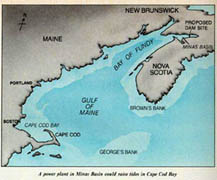 The Bay of Fundy
The Bay of Fundy
 source
unkown (amimation)
source
unkown (amimation)

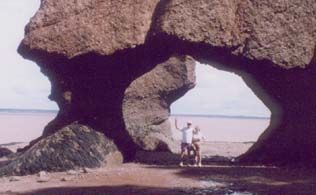
Wave-cut sea arches (who is that dude with the babe?) Flowerpot Rocks (New Brunswick Canada) |

Fossil Cliffs (near Bay of Fundy) Joggins (Nova Scotia Canada) |
 (animation)
(animation)
Beach Drift
A phenomenon known a wave refraction results when waves slow down as they approach the surf zone. This is similar to the bending of light in a prism. This means that the wave front changes its direction (coming in more perpendicular) as it hits the shore. Click here to see a diagram of refraction or here.
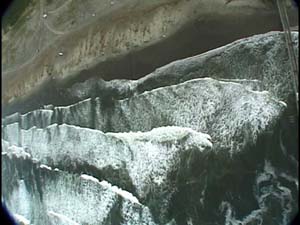
Sorry .. I can't locate the source for credit
This produces an interesting result. Let's imagine a shoreline which has an irregular shape ... with protruding headlands and inset bays. The animation below shows how wave refraction will attach the headlands (which allows sediments to gradually fill the bays).
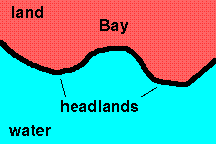
How waves attach an irregular coastline (animation)
The net result is that the wave action erodes the headlands and tends to make irregular coastlines straighter.
Links:
http://pubs.usgs.gov/circular/c1075/change.html
http://www.tulane.edu/~sanelson/geol111/oceans.htm
ŠJim Mihal 2004, 2006 - all rights reserved